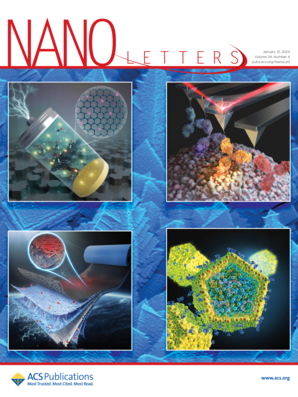Lamellar Nanoporous Intermetallic Cobalt-Titanium Multisite Electrocatalyst with Extraordinary Activity and Durability for the Hydrogen Evolution Reaction
IF 9.6
1区 材料科学
Q1 CHEMISTRY, MULTIDISCIPLINARY
引用次数: 0
Abstract
Constructing well-defined multisites with high activity and durability is crucial for the development of highly efficient electrocatalysts toward multiple-intermediate reactions. Here we report negative mixing enthalpy caused intermetallic cobalt-titanium (Co3Ti) nanoprecipitates on a lamellar hierarchical nanoporous cobalt skeleton as a high-performance nonprecious multisite electrocatalyst for an alkaline hydrogen evolution reaction. The intermetallic Co3Ti as a robust multisite substantially boosts the reaction kinetics of water dissociation and hydrogen adsorption/combination by unisonous adsorptions of hydrogen and hydroxyl intermediates with proper binding energies. By virtue of a bicontinuous and hierarchical nanoporous cobalt skeleton that enables sufficiently accessible Co3Ti multisites and facilitates electron transfer and ion/molecule transportation, a self-supported nanoporous cobalt-titanium heterogeneous electrode exhibits extraordinary electrocatalytic activity and durability toward the hydrogen evolution reaction in 1 M KOH. It reaches a current density of as high as ∼3.31 A cm–2 at a low overpotential of 200 mV and maintains exceptional stability at ∼1.33 A cm–2 for >1000 h.

求助全文
约1分钟内获得全文
求助全文
来源期刊

Nano Letters
工程技术-材料科学:综合
CiteScore
16.80
自引率
2.80%
发文量
1182
审稿时长
1.4 months
期刊介绍:
Nano Letters serves as a dynamic platform for promptly disseminating original results in fundamental, applied, and emerging research across all facets of nanoscience and nanotechnology. A pivotal criterion for inclusion within Nano Letters is the convergence of at least two different areas or disciplines, ensuring a rich interdisciplinary scope. The journal is dedicated to fostering exploration in diverse areas, including:
- Experimental and theoretical findings on physical, chemical, and biological phenomena at the nanoscale
- Synthesis, characterization, and processing of organic, inorganic, polymer, and hybrid nanomaterials through physical, chemical, and biological methodologies
- Modeling and simulation of synthetic, assembly, and interaction processes
- Realization of integrated nanostructures and nano-engineered devices exhibiting advanced performance
- Applications of nanoscale materials in living and environmental systems
Nano Letters is committed to advancing and showcasing groundbreaking research that intersects various domains, fostering innovation and collaboration in the ever-evolving field of nanoscience and nanotechnology.
 求助内容:
求助内容: 应助结果提醒方式:
应助结果提醒方式:


